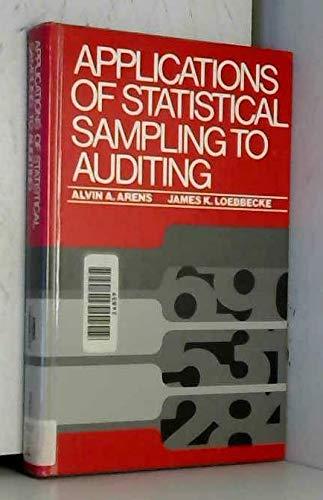The following multiple-choice questions about attributes sampling and related issues were taken from recent CPA examinations: a.
Question:
The following multiple-choice questions about attributes sampling and related issues were taken from recent CPA examinations:
a. There are many kinds of statistical estimates that an auditor may find useful, but basically, every accounting estimate is either of a quantity or of an error rate. The statistical terms that roughly correspond to “quantities” and “error rate” respectively are:
(i) Attributes and variables
(ii) Variables and attributes
(iii) Constants and attributes
(iv) Constants and variables
b. The purpose of tests for compliance is to provide reasonable assurance that the accounting control procedures are being applied as prescribed. The sampling method that is most useful when testing for compliance is:
(i)Judgmental sampling
(ii)Attributes sampling
(iii) Unrestricted random sampling with replacement
(iv) Stratified random sampling
c. An example of sampling for attributes would be estimating the:
(i) Quantity of specific inventory items
(ii)Probability of losing a patent infringement case (iii) Percentage of overdue accounts receivable (iv) Dollar value of accounts receivable
d. The auditor’s failure to recognize an error in an amount or an error in an internal control data processing procedure is described as a:
(i) Statistical error (ii) Sampling error (iii) Standard error of the mean (iv) Nonsampling error
e. For a large population of cash disbursement transactions, Janet Smith, CPA, is testing compliance with internal control by using attributes sampling techniques. Anticipating an occurrence rate of 3 percent, she finds from a table that the required sample size is 400, with a desired upper precision limit of 5 percent and a reliability of 95 percent. If Smith anticipates an occurrence rate of only 2 percent but wants to maintain the same desired upper precision limit and reliability, the sample size would be closest to:
(i) 200 (ii) 400 (iii) 533 (iv) 800
f. When using statistical sampling for tests of compliance, an auditor’s evaluation of compliance would include a statistical conclusion concerning whether:
(i) Procedural deviations in the population were within an acceptable range (ii) Monetary precision is in excess of a certain predetermined amount (iii) The population total is not in error by more than a fixed amount (iv) Population characteristics occur at least once in the population g. Which of the following best describes what the auditor means by the rate of occurrence in an attributes sampling plan ?
(i) The number of errors that can reasonably be expected to be found in a population (ii) The frequency with which a certain characteristic occurs within a population (iii) The degree of confidence that the sample is representative of the population (iv) The dollar range within which the true population total can be expected to fall h. To satisfy the auditing standard to make a proper study and evaluation of internal control, Harvey Jones, CPA, uses statistical sampling to test compliance with internal control procedures. Why does Jones use this statistical sampling technique?
(i) It provides a means of measuring mathematically the degree of reliability that results from examining only part of the data.
(ii) It reduces the use ofjudgment required of Jones, because the AICPA has established numerical criteria for this type of testing.
iii) It increases Jones’s knowledge of the client’s prescribed procedures and their limitations.
(iv) It is specified by generally accepted auditing standards.
Step by Step Answer:

Applications Of Statistical Sampling To Auditing
ISBN: 9780130391568
1st Edition
Authors: Alvin A. Arens, James K. Loebbecke





